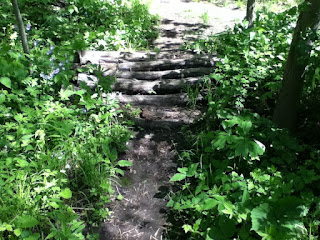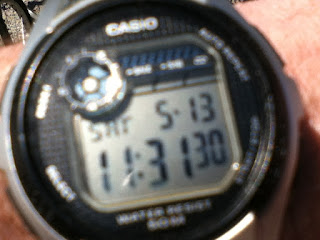Last weekend's 4th annual tour of recent bicycle infrastructure in the metropolitan area featured a range of projects oriented to trail riders, bicycle commuters, and in some cases both. Those of us accustomed to the foul weather that has accompanied recent MPO rides were pleasantly surprised by the sunshine and pleasant breezes ("More like RAGBRAI, without pie," said one awed participant). Linn County Trails Association's chief trail counter John Wauer counted 49 riders in the morning, which was at least triple last year's delegation. Though this had to make it more logistically challenging for ride leaders, it was good to get the good news out to more people.
We gathered at the New Bo City Market, along with a huge group gathered to walk for the Juvenile Diabetes Research Foundation. So great to see people taking advantage of the weather and Cedar Rapids's increasing walkability to work for a good cause!
 |
| The Eastern Iowa chapter of the JDRF does not do things by halves |
 |
| We found each other among the throng |
First stop was along F Avenue NE, near the new athletic complex being constructed by Mount Mercy University.
Phillip Platz from their public relations department, who is also a member of the Linn County Trails Association, said they're hoping for completion by August 1, with grand opening scheduled for September 30.
The CeMar trail will run along F Avenue and through these athletic fields--land donated by Mount Mercy--and will eventually tunnel under 1st Avenue to connect the Cedar River Trail with the Marion Parks Trails. The land between the colleges seems primed for growth, and in September this very spot will be the site of a tactical urbanism event put on by the group Corridor Urbanism, about which more in time.
We rode north, across 42nd Street where the Cedar River Trail crosses the off-ramp from interstate 380... still an awkward encounter, but the interface is much improved.
If it's awkward you're after, though, you can't beat the construction zone north of Blairs Ferry Road. During this stretch the trail crosses Center Point Road before heading north to join the Cedar Valley Nature Trails. I'm sure it will be great when it's done.
The trail crossing at Boyson Road features new trail crossing indicators, just installed the previous day. Push a button on one of the posts on either side of the trail, placed at just the right height for a rider to reach--though I failed to connect when I tried to push it while still on the move.
The buttons trigger flashing lights on the road signs which warn drivers--and they stopped!
Ready to stop for lunch! at Lebowski's Bar & Grill in Robins Square, a few blocks down Main Street from the trail, and dedicated to Jeff Bridges's character in the 1998 film "The Big Lebowski." (Quotes from the movie appear on a poster on the wall.)
Back on the road, we returned to 42nd Street and then pushed all the way west past Xavier High School to the Rock Island Preserve.
The plan is to have a trail through here from Seminole Valley Park to the south, then up to the Route 100 extension (somewhat visible in the picture above), across the Cedar River and then south near the highway to the Cherokee Trail planned to run west out of downtown Cedar Rapids. This will be a multi-year process, however.
We rode down Edgewood Road--very exciting, but not nearly as exciting as Stoney Point Road in the wind last year--to Ellis Park, where we took the Ellis Trail downtown. Finally, we were told about progress on the Sleeping Giant bridge south of Czech Village, how trails in that area will be reconstructed after the flood walls are put in, and the importance of reporting trail counts to the LCTA.
I engaged in some critical thinking while I rode, which is not easy to manage when one is also pushing an out-of-shape body along a reported 26 miles, not running into people, and remembering to shout "Car back!" But I'd recently read an article by Rachel Quednau on the Strong Towns blog, which in turn referenced an article in Bicycling magazine, arguing that cities often neglect the poorest cyclists when developing cycling infrastructure. These are folks who, in Quednau's words, "use their bikes to get to work, not to save a little money or for the purposes of exercise, but because they have no other option." A survey by the Los Angeles County Bicycle Coalition found 40 percent of respondents they approached on the street (as opposed to those surveyed by Internet or mail) earned less than $15,000 annually.... in Los Angeles! Here's Quednau quoting Dan Koeppel in Bicycling:
Neighborhood after neighborhood revealed surprise after surprise. The Invisible Riders, for instance, log far more hours than most "serious" cyclists. They do so on equipment most of us wouldn't touch and under the most adverse conditions: at the height of rush hour on the busiest thoroughfares. [...] Most of the riders I met viewed their commute as a battle, but exhibited none of the smug, anti-automotive posturing many committed middle-class bike commuters wear as a badge of honor.Besides forswearing smugness, which we should all do simply for the well-being of our own souls, we are reminded by Koeppel and Quednau that we need to be developing cycling infrastructure for the whole community, not merely to respond to the desires of a vocal group. Recreational trails are valuable assets, but are we also helping people get to work?
 | ||||
With mountain bike trails? Well, probably not
|
The new infrastructure the MPO has featured on these annual rides serves, as far as I can tell, both riders of choice and riders of necessity. It's unlikely, of course, many people are using the Cedar Valley Nature Trail to get to work, but a well-planned urban trail network can spare commuting cyclists of all income levels some of the rigors of rush hour. There's some evidence poverty in our metropolitan area has dispersed in recent years, but the Cedar River Trail, the Lindale Trail and the proposed Cherokee Trail all connect low-income areas with downtown. Poor people in core neighborhoods benefit from bike lanes on commuter streets as well as efforts to slow cars through residential areas through road diets and one-way-to-two-way conversions. Cedar Rapids for decades developed as though everyone could and would make all essential daily trips by motor vehicle. As we roll into Bike to Work Week, the progress we've made in commuter cycling can help people get along without cars, which is a huge boost to the ol' standard of living.
EARLIER POSTS
"MPO Ride," 15 May 2016
"Riding on Infrastructure with the Corridor MPO," 2 June 2015




















No comments:
Post a Comment